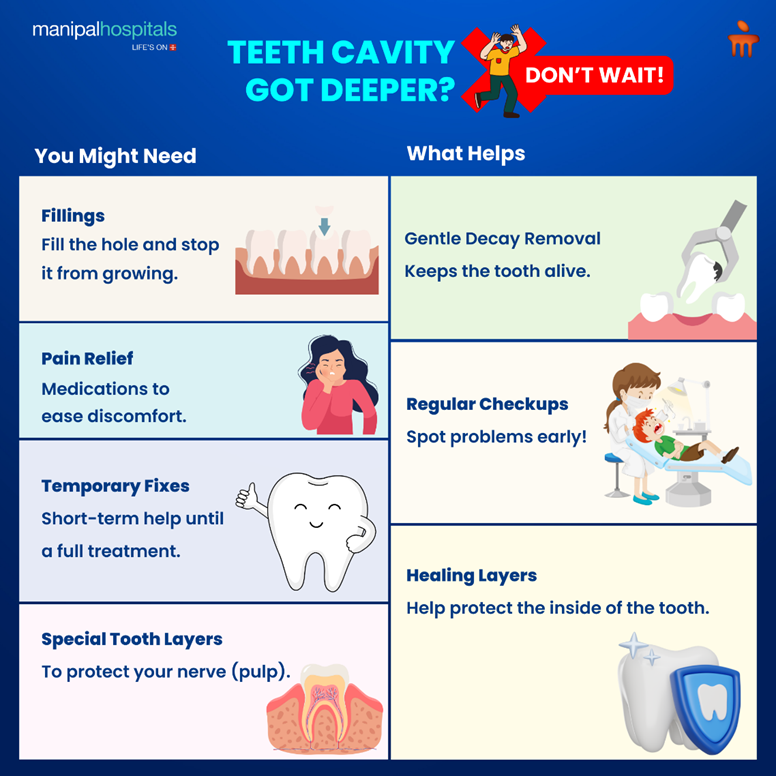
Deep caries refers to the progressive advancement of tooth decay into the deeper layers of the tooth, including the dentin and potentially the pulp. If left untreated, it can result in toothache, pulpitis, or even abscess formation and may contribute to further dental complications. If the pulp is exposed due to caries, fillings are impossible; the dentin-pulp complex may start to die.
Early detection to opt for indirect pulp capping and root canal treatment can save a tooth and prevent such complications. Some of these may include the LASER root canal treatment, which takes less time to heal and is less painful. In this blog an experienced dentist in Sarjapur Road, Bangalore, discusses the causes, signs, symptoms, and diagnosis of deep caries.
Synopsis
Early Stages of Dental Decay and Treatment Options
Cavities form in a progression starting on the outer surface of the enamel and deeper into the enamel if the cavity is not treated. The following are some of the key treatments, although preventive measures should be taken to ensure one does not have to undergo the rigorous process of therapy:
-
Dental Fillings: Dental fillings are used when small carious lesions only involve the outer surface of the dentin or the enamel. These fillings not only fill the cavity but also help rebuild lost tooth structure and provide protection against further wear.
-
Fluoride Treatment: In the early stage of tooth decay, fluorides help increase the hardness of the outer surface layer of the teeth. They strengthen the surface of teeth to some extent to ensure that no deep cavities erupt again.
-
Sealants: Specifically for children and adults with high caries risk, sealants form an extra barrier to the chewing surfaces, mainly on molars. This can also decrease the chances of food accumulation on parts of the teeth, reducing tooth decay.
-
Professional Cleanings: Diseases such as caries arise due to the buildup of plaque and tartar, which are eradicated by a teeth check-up and a cleaning session. However, it is essential to say that this is among the most effective measures that can be taken to prevent other periodontal diseases.
-
Dietary Changes: Sugar consumption and acidic food products must be reduced to reduce potential dental decay. These substances contribute to the growth of pathogenic microorganisms, leading to deeper caries and painful teeth.
-
Good Oral Hygiene: In addition to brushing at least twice a day, flossing and using mouthwash are required to reduce the risk of severe tooth decay and deep caries in the future.

Managing Deep Caries and Pain Relief
When dental decay reaches the deeper dentin layers, it can cause severe tooth pain and sensitivity. Managing this condition requires more advanced treatment:
-
Indirect Pulp Capping: This technique is used when deep caries is close to the pulp but has not yet infected it. It involves removing the decayed portion and placing a biocompatible material to encourage healing and prevent further infection.
-
Selective Caries Removal: This approach aims to remove only the soft, infected dentin, leaving the more complex, less infected layers to avoid exposing the pulp. This can help reduce tooth sensitivity and prolong tooth life.
-
Temporary Fillings: In some cases, a temporary filling is placed to allow the tooth to recover before a more permanent solution is used. This is common when there is severe tooth pain and inflammation.
-
Medication for Pain Relief: Before definitive treatment, over-the-counter pain relievers and antibiotics may be prescribed to reduce tooth pain and control infection.
-
Cavity Liners and Bases: Special materials can insulate the pulp and reduce tooth sensitivity before a permanent filling.
-
Monitoring and Regular Check-ups: Regular dental visits are crucial for the early detection of deep caries, monitoring progress, and avoiding further complications.
Recent Advancements in Root Canal Treatment
Modern root canal treatment techniques have significantly improved patient comfort and outcomes. Here are some of the latest advancements:
-
Laser-Assisted Root Canal Treatment (LARCT): This technique uses laser technology to clean and disinfect the canals precisely, reducing the risk of reinfection and ensuring a more thorough cleaning.
-
Better Precision: The laser allows for precise removal of infected tissue, preserving more of the natural tooth structure.
-
Faster Healing: Patients typically experience less post-procedure pain and quicker recovery with laser-assisted procedures.
-
Reduced Discomfort: The laser’s accuracy and ability to target only infected areas minimise the discomfort associated with traditional root canal treatment.
-
Preservation of Tooth Structure: Unlike conventional methods, laser treatments often require less removal of the natural tooth, preserving more of the original structure.
-
Reduced Risk of Reinfection: The laser's sterilising effect reduces the chances of bacterial reinfection, improving long-term outcomes.
Conclusion
Early detection and treatment of deep caries can prevent extensive tooth pain and the need for more invasive procedures like root canal treatment. With advancements like laser-assisted root canals, patients have more effective and comfortable options for preserving their natural teeth. If you are experiencing tooth pain or suspect deep caries, consult an experienced dentist at Manipal Hospital Sarjapur Road for personalised care and effective treatment.
FAQ's
Deep caries is caused by prolonged exposure to acids from plaque bacteria, poor oral hygiene, frequent sugary diets, and a lack of regular dental care. These factors break down enamel and expose the dentin, leading to rapid decay.
Indirect pulp capping is typically painless, as it is performed under local anaesthesia. It aims to preserve the tooth's vitality and prevent further tooth pain.
A root canal treatment usually takes 1-2 visits, depending on the tooth's complexity and the extent of the infection. Each session may last 60-90 minutes.
Yes, laser root canals offer greater precision, faster healing, reduced discomfort, and a lower risk of reinfection compared to traditional methods.
Once deep caries has reached the dentin, it cannot be fully reversed, but early intervention can stop further damage and restore tooth health.





















 8 Min Read
8 Min Read












